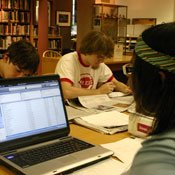After months of planning and research, along with three hour-long interviews with editors from the Northside Sun, The Jackson Advocate and the Madison County Journal, The Jackson Media Literacy Project associates have compiled a list of suggestions for the local papers and the community they serve.
1. Local papers can improve coverage by doing more "human interest" stories on youth, whether about academic success or non-athletic extra-curricular success. When youth coverage is focused on crime, education problems and non-academic success (generally on the athletic fields), academic success and other extracurricular activities becomes less important to youth because they are not as recognized for it.
2. When writing about local youth, make an effort to go beyond short blurbs or stand-alone pictures. Blurbs and pictures only briefly highlight youth accomplishment. By limiting the scope to only short articles, journalists miss out on the more dynamic stories that describe youth accomplishment beyond photo-shoot opportunities. Talk with area youth, and include what they have to say in the discussion.
3. Local media outlets should consider having youth columns or sections. This could present readers with information sent in by youth, about youth or edited by youth, if not all of the above. It can be a part of the paper every two or three publications. Contact each of the schools or community centers in the region asking for youth articles. There are sure to be young people out there who want to publish their thoughts.
4. Make an active effort to increase racial, social and economic diversity of the students in your newspaper, so that the diverse membership of Jackson-area schools can see themselves in the paper, and not just in sports or crime stories. Especially encourage youth that aren't often represented to share information about their peers' accomplishments. Encourage under-represented youth to make contributions to the paper. When under-represented young people read the work of their peers in the paper, they will become more inclined to read in the future, knowing that the editorial staff makes their voice a priority.
5. Consider the thought that today's youth will be soon be adults, and adults engage in conversations, not lectures about them.
6. It doesn't stop with the media. Community members should work closely with local media to develop a partnership between media outlets and schools allowing interested students to work for a semester or two under an editor. Getting youth into the newsroom will help maintain a more balanced coverage, as young people bring a new perspective to the newsroom.
7. We also encourage the community to send your work. Area papers can't bring a voice to the community if no one is willing to speak up. If you feel like certain members of the community aren't being representing properly, write a letter to the editor and request it be published. Or better yet, become the media yourself by writing an article. Take pictures and send all the information to your local paper. Work with the editorial staff on getting it published.
8. Be active. If newspapers' coverage truly reflects the community, then the coverage will only be as good as the members of the community. Join community-service efforts in your area. Run for public office. If you want to see local media portray your community in a positive light, do all that you can to make your neighborhood a positive place to live.
9. If members of a community see an event, good or bad, in his or her community that stirs up strong feelings, they should report it to a local media outlet. No newspaper or newstation can report a story they don't get a lead on.



Comments
Use the comment form below to begin a discussion about this content.
comments powered by Disqus